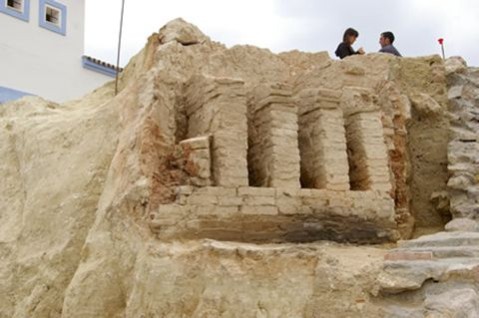
Municipal workers clearing a site in Manilva back in 2011 made a remarkable find. Under the rubble of buildings demolished to make way for a new park, they uncovered what turned out to be the well-preserved remains of a Roman kiln dating back to the first part of the second century AD. As soon as they were made aware of the find, which is situated on the now empty space, right next to the CIVIMA building, the Manilva Wine Centre, the Town Hall were quick to call in a team of archaeologists who were based at the Museum in El Castillo de la Duquesa. After preliminary excavation of the structure, the archaeologists were able to determine the date of the kiln which may be of a design never before found in Andalucia and might even be unique in all of Spain and in Italy as well. Given the archaeological importance of the Manilva kiln, it became a matter of urgency that arrangements be made to fund its preservation. Of course, this type of rescue project required financial support and the decision to fund the work was taken by the Junta de Andalucia’s Ministry of Culture.
Although just a few fragments of pottery have been found near the kiln, broken pieces of a large circular-shaped stone indicate its probable use as a potter’s wheel. But the real significance of the kiln is in its design: a series of brick-lined chambers where the clay objects were placed to be fired with the heat coming from a large furnace built underneath the firing chambers. The bowls and cups that it produced were almost certainly used locally but perhaps (we can only speculate) the ‘amphoras’ (storage vessels) that were packed full of the fishy ‘garum’ paste made in what is now Castillo, were produced here and then shipped off to Rome full of their precious cargo. There are heaps of broken pottery from Spain still found in and around the ‘Eternal City’  perhaps a few shards of Manilva ware are still lying there!
For the time being, the Manilva kiln will be kept under wraps to protect it from the elements until it can be consolidated and then prepared for public display. An explanatory plaque will be created so that local people and visitors can fully appreciate the role of the kiln in the history of Manilva area which is both rich and varied. Unfortunately, so much of this heritage has been destroyed in the past, by treasure hunters looting archaeological sites and by developers whose tight budgets and deadlines have made no allowances for investigation into any remains their bulldozers may have uncovered. What we do have left to us should be jealously guarded and preserved. Thankfully works have begun to preserve and display the important Roman remains at Castillo which for years were left in a sorry state, covered in rubbish and looking very shabby. It’s about time we put Manilva on the map as a cultural heritage destination.
![]()





